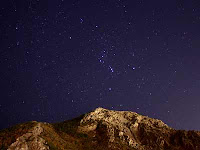
A couple of decades ago, when I was still using a fully manual SLR film camera, I tried some simple astrophotography: Long-exposure photos of star trails from a fixed tripod, and also some “piggyback” photos with the camera mounted on a small motor-driven telescope to track the stars. The results were satisfying but hardly spectacular, and the time required was substantial enough that my priorities soon turned elsewhere.
Then last January, at the start of the International Year of Astronomy, my interest in astrophotography began to return. By then I was using a marvelous little Canon point-and-shoot digital camera, and I was delighted to learn that it would take time exposures as long as 15 seconds. While spending the New Year’s holiday in remote Boulder, Utah (about as far from city lights as you can get in the contiguous 48 states), I decided to brave the cold and try a few shots of the winter constellations.
To my astonishment, that little camera recorded 10 times as many stars as my eye could see. Unfortunately, the photos were also plagued by digital noise that severely limited the aesthetic possibilities. I suppose this noise is the digital equivalent of the grainy appearance of photos on high-speed film.
Meanwhile, I had been marveling at the ever-better scenic night photos posted on NASA’s Astronomy Picture of the Day site. Following the links from some of my favorites, I discovered sites like TWAN and The Sky In Motion. These photographers were using digital SLR cameras to make stunning photos showing the sky in great detail behind interesting foreground scenes. The noise levels were acceptable, because DSLR cameras have bigger and better electronic sensors than my point-and-shoot.
A terrific resource for would-be astrophotographers is Jerry Lodriguss’s web site, Catching the Light. One of his technical articles indicates that even some of the cheapest consumer-model DSLR’s can produce excellent night shots. But did I want to spend even $500 for such a special-purpose toy? “Well,” I rationalized, “I’ve already had two astronomy students use DSLR cameras for their observing projects, and I need to learn how to help them when necessary.”
I got the new camera on September 10. Then even I, a professional geek, had to spend a week just getting familiar with all the buttons and menus. I also discovered that to shoot exposures longer than 30 seconds (without a computer connected), I needed to get a $25 remote switch. Finally prepared, I headed up to Ogden’s foothills on a couple of our recent spectacular September nights. The best shots from these sessions are posted here. In short, I'm amazed at what can now be done with amateur equipment and very little effort.
Incidentally, this was the first time I’ve ever been glad for light pollution. Although scattered light from the city brightened the sky (and pretty much ruined any shots facing west), that same light pollution cast beautiful illumination on Ogden’s mountains.
How much further I’ll take this hobby, I have no idea. Certainly I’ll try some photos from a few other sites around Ogden. And I’ll bring the new camera on camping trips, to see what it can do from some darker locations. Perhaps I’ll try to schedule these trips to coincide with favorable moonlight to illuminate the scenery.
But I’m not a professional photographer, so if you want to see really nice photos of the sky, follow the links above.
